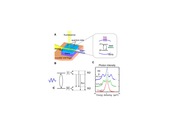Highlight
Coherent Control of a Single Quantum Dot in a Micro-Cavity
Achievement/Results
Funded in part by the NSF Integrative Graduate Education and Research Traineeship program, the IGERT trainee, John Robertson, in collaboration with other graduate students and postdoctoral fellows in the research group of Professor C. K. Shih (IGERT faculty), have performed the first resonance fluorescence and coherent control of Semiconductor Quantum Dots, an achievement that has so far proven elusive because their surrounding environment tends to easily scatter light. This difficulty has been one main hurdle toward progress in using Quantum Dots in Quantum Computation and Communication schemes, because it is difficult to perform experiments where the input laser excitation light is resonant with the optical transition of the Quantum Dot. They were able to overcome this difficulty by exciting the Quantum Dots from the side, using guided modes of a surrounding planar optical micro-cavity that also served as a mechanism to suppress scattering of the input excitation laser light (Figure A). As proof that they were indeed able to perform resonance fluorescence, they reported the signature spectrum of a two level system excited on resonance by an intense optical field: a three peaked fluorescence spectrum that is most easily understood in the so-called dressed state picture. Here, when a two-level system is coherently driven by a strong laser field, it undergoes a coherent oscillation called Rabi oscillation whose frequency is directly proportional to the field strength. Consequently, the two level transition splits into 4-manifolds where two of the transitions maintain the original transition frequency (central peak) while one other transition occurs at a lower energy and the other one at higher energy (Figure B). The resulting a spectrum is often referred to as the Mollow triplets as observed in Figure C where energy separation of the split-off side band scales with the magnitude of the excitation field. These experimental results represent a significant step in the progress toward utilizing Quantum Dots as systems to perform Quantum Computation and Communication. In addition to opening up the possibility of any scheme that requires excitation and emission light to be of the same wavelength, these results also allow for the excitation power to be much stronger than the saturation power of the Quantum Dots.
The researchers demonstrate the first coherent control of a single Quantum Dot and present its resonance fluorescence spectrum. They also report evidence of a strong field excitation, as shown by oscillations in the second order correlation function measured from the emitted light of the Quantum Dot. This represents a significant step in progress towards fully realizing Quantum Dot Applications in Quantum Information Science.
Citation of Publication: Resonantly driven coherent oscillations in a solid-state quantum emitter, E. B. Flagg, A. Muller, J. W. Robertson, S. Founta, D. G. Deppe, M. Xiao, W. Ma, G. J. Salamo, and C. K. Shih, Nature Physics 5, 203 (2009).
Address Goals
The team enhanced the research structure of this Nation by developing new experimental tools that enabled the novel excitation and collection scheme. This sophisticated instrumentation is unique in that it allows an entirely new geometry for exciting and collecting radiation from an emitter embedded in a semiconductor wafer. As shown by the emerging publications within the Quantum Dot community during recent months, this work has transformed the direction of the field. Multiple groups have adopted this technique to utilize for their own experiments, and one group has improved upon it with a slightly different cavity structure (Muller et al, Phys. Rev. Lett. 101, 027401 (2008), Ates et al, arXiv:0902.3612v1). This work advanced human knowledge of Quantum Dots and has opened up new possibilities for their applications in Quantum Information Science. This work also indicates that any experiment or Quantum Information Application that requires coherent control and the excitation and emission wavelengths to be equal is now feasible.







